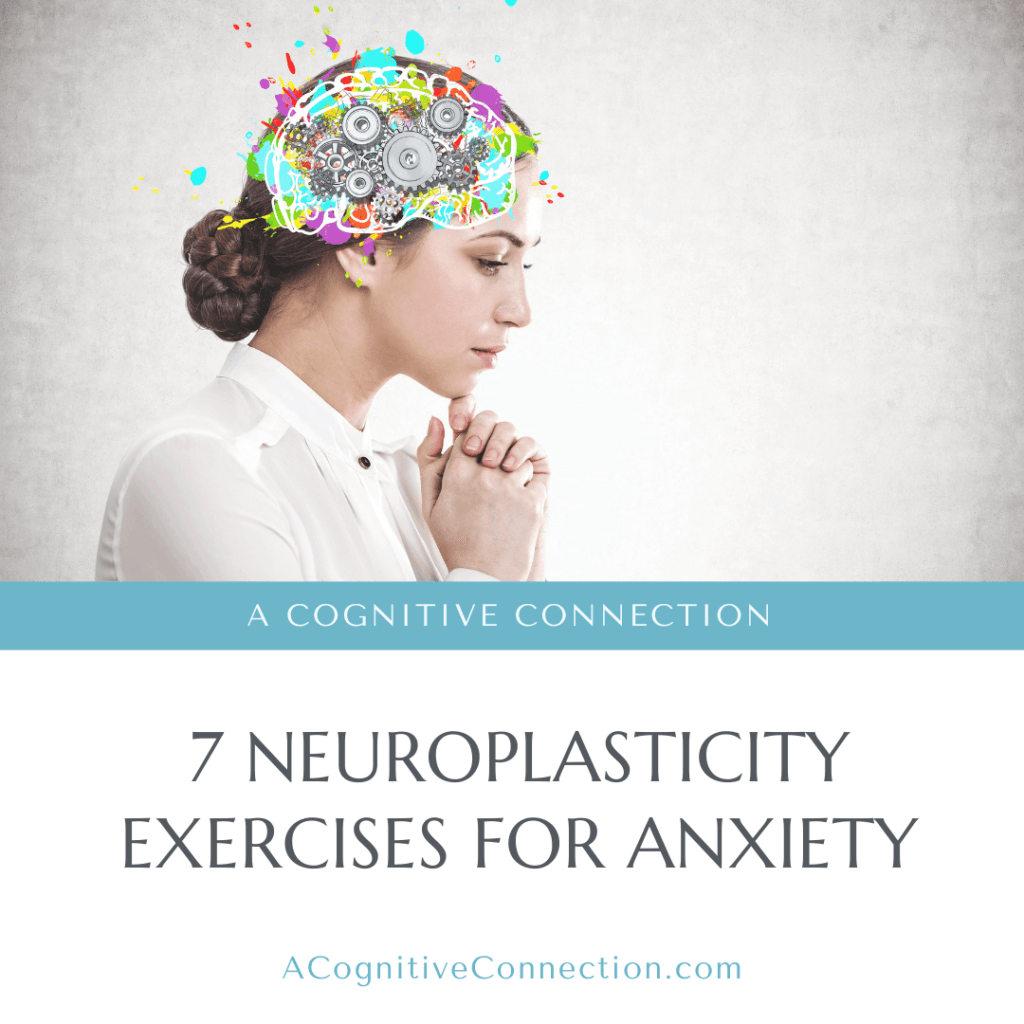According to the National Institute of Mental Health, about 30% of U.S. adults will struggle with some form of anxiety. Anxiety disorders can be debilitating and negatively impact your quality of life, but what if there was a way to retrain your brain to be less anxious? Improving your neuroplasticity and building neural pathways that promote calmness and confidence can make a huge difference! Keep reading to learn a few neuroplasticity exercises for anxiety that you can try at home.
If anxiety is a daily struggle, you may need additional support to find a suitable treatment option. As a cognitive and behavioral center in Colorado Springs, A Cognitive Connection can help you improve your neuroplasticity while exploring counseling and other treatment options.
What is Neuroplasticity?
Neuroplasticity refers to the ability of the brain to form new neural pathways and reorganize itself in response to experiences, learning, and changes in your environment. Neuroplasticity allows us to learn new skills and make behavioral changes.
The brain forms new neural pathways daily without any intentional effort from us. But you can also do certain things to stimulate growth in a particular direction. For example, if you take up a challenging hobby like playing an instrument or learning a new language, this can influence the structure of your brain.
Neuroplasticity is responsible for why we improve with practice and why trauma can have long-term mental health effects.
How Can Neuroplasticity Help with Anxiety?
The more often you use a neural pathway, the more ingrained that skill or behavior becomes. So if you have a panic attack every time you go to the store, over time, that will become your brain’s default response to the situation. By building neural pathways that promote calmness and confidence, you give your brain an alternative response. The pathways that led to your panic attack won’t go away, but you may be able to make other pathways more dominant.
If you have severe anxiety, you may want to seek help from a professional therapist who can help you find and practice alternative responses.
Neuroplasticity Exercises to Try at Home
1. Meditation
Meditation is a great way to relax, reduce stress and anxiety, and improve mental clarity. Start by closing your eyes for 10 minutes each day and focusing on your breath. Don’t worry about doing it “right”—just focus on being still and breathing deeply from your diaphragm.
Like any new skill, the more you practice meditation and calmness, the easier it will become. Eventually, you may be able to use meditation in a situation of heightened anxiety to engage other neural pathways.
2. Learning a New Skill

Learning something new can help your brain form neural pathways that support a calmer mindset. Any new skill improves your brain’s ability to rewire itself, and doing something you enjoy can also help anxiety in other ways. Here are a few ideas to get you started:
- Learning an instrument
- Juggling
- Gardening
- Painting or crafting
- Writing with your non-dominant hand
3. Changing your Thought Patterns
Thoughts are powerful, and how you think about a situation can have a significant impact on your anxiety levels. When you’re anxious, try to challenge your thoughts by asking yourself questions like, “What evidence do I have that this will actually happen?” or “Is there another way of looking at this?” By re-framing the situation, you can give your brain a different pathway to engage.
In fact, cognitive behavioral therapy, a common treatment for anxiety, encourages this type of reframing.
4. Physical Exercise
Physical exercise is another form of neuroplasticity in action. When you move your body, it changes the structure and chemistry of your brain cells. Exercise releases endorphins, which can help with anxiety and depression by lifting your mood.
Try engaging in regular physical activity, like walking or running, for at least 30 minutes daily. Not only will it help your brain create new pathways, but you’ll also benefit from the many other health benefits of physical exercise.
5. Studying Something New
Challenging your brain is a great way to stimulate neuroplasticity and reduce anxiety. Similar to learning a new skill, exploring a subject you are unfamiliar with creates more neural pathways in the brain, which can help with problem-solving and decision-making.
Try a class or online course related to a subject that interests you. It doesn’t have to be associated with anxiety, just something that grabs your attention and keeps you motivated. In this case, a large, complicated subject can be helpful, just don’t overwhelm yourself.
6. Doing a Challenging Brain Activity
Playing games, like crosswords or Sudoku, is a great way to keep your mind active and organized. Try adding regular brain activities to your day to help reduce anxiety. This can help create new neural pathways by engaging different parts of the mind and encouraging creative problem-solving.
7. Working on Recall and Memory
Improving your recall and memory can also help with anxiety. Try memorizing a poem or passages from a book or listing out facts related to something you are studying. Doing this kind of activity helps create new connections in the brain that can help you think more clearly and make better decisions. A Cognitive Connection also offers a free workbook with memory exercises that can help you get started.
Need Help with Anxiety?
These are just a few of the ways that neuroplasticity can help reduce anxiety and improve your well-being. With practice and dedication, it is possible to make lasting changes in how you think and feel.
If you’re struggling with anxiety, however, consider seeking additional support from a mental health professional. A Cognitive Connection has several professional therapists that would love to connect with you. We can help you identify the underlying causes of your anxiety and provide guidance on how to create a healthier mindset. Schedule a free consultation to see how we can support you.


